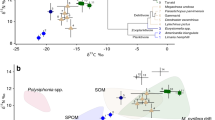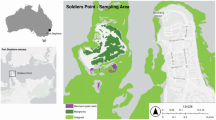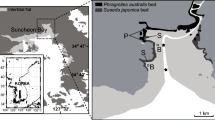Abstract
Loss of macroalgae habitats has been widespread on rocky marine coastlines of the eastern Korean peninsula, and efforts for restoration and creation of macroalgal beds have increasingly been made to mitigate these habitat losses. Deploying artificial reefs of concrete pyramids with kelps attached has been commonly used and applied in this study. As a part of an effort to evaluate structural and functional recovery of created and restored habitat, the macroalgal community and food web structure were studied about a year after the establishment of the artificial macroalgal bed, making comparisons with nearby natural counterparts and barren ground communities. Dominant species, total abundance, and community structure of macroalgal assemblage at the restored macroalgal bed recovered to the neighboring natural bed levels during the study period. The main primary producers (phytoplankton and macroalgae) were isotopically well separated. δ13C and δ15N values of consumers were very similar between restored and natural beds but varied greatly among functional feeding groups. The range of consumer δ13C was as wide as that of primary producers, indicating the trophic importance of both producers. There was a stepwise trophic enrichment in δ15N with increasing trophic level. A comparison of isotope signatures between primary producers and consumers showed that, while suspension feeders are highly dependent on pelagic sources, invertebrates of other feeding guilds and fishes mainly use macroalgae-derived organic matter as their ultimate nutritional sources in both macroalgal beds, emphasizing the high equivalency of trophic structure between both beds. Isotopic signatures of a few mollusks and sea urchins showed that they use different dietary items in macroalgal-barren grounds compared with macroalgal beds, probably reflecting their feeding plasticity according to the low macroalgal biomass. However, isotopic signatures of most of the consumers at the barren ground were consistent with those at the macroalgal beds, supporting the important trophic role of drifting algae. Our results revealed the recoveries of the macroalgal community and trophic structure at the restored habitat. Further studies on colonization of early settlers and the following succession progress are needed to better understand the process and recovery rate in the developing benthic community.





Similar content being viewed by others
References
Barnes RD (1987) Invertebrate zoology, 5th edn. Saunders College Publishing, Philadelphia
Bligh EG, Dyer WJ (1959) A rapid method of total lipid extraction and purification. Can J Biochem Physiol 37:911–917
Bode A, Alvarez-Ossorio MT, Varela M (2006) Phytoplankton and macrophyte contributions to littoral food webs in the Galician upwelling estimated from stable isotopes. Mar Ecol Prog Ser 318:89–102
Bone Q, Carré C, Chang P (2003) Tunicate feeding filters. J Mar Biolog Assoc UK 83:907–919
Bunn SE, Loneragan NR, Kempster MA (1995) Effects of acid washing on stable isotope ratios of C and N in penaeid shrimp and seagrass: implication for food-web studies using multiple stable isotopes. Limnol Oceanogr 40:633–625
Bustamante RH, Branch GM (1996) The importance of intertidal consumers on kelp-derived organic matter on the west coast of South Africa. J Exp Mar Biol Ecol 196:1–28
Bustamante RH, Branch GM, Aekhout S (1995) Maintenance of an exceptional grazer biomass on South African intertidal shores: trophic subsidy by subtidal kelps. Ecology 76:2314–2329
Choi CG, Kwak SN, Shon CH (2006) Community structure of subtidal marine algae at Uljin on the east coast of Korea. Algae 21:463–470 (in Korean with English abstract)
Chung HS, Lee HJ, Lee IK (1991) Vertical distribution of marine algae on Gallam rocky shore of the mid-east coast of Korea. Korean J Phycol 6:55–67
Clarke KR, Warwick RM (1994) Changes in marine communities: an approach to statistical analysis and interpretation. National Environmental Research Council, Plymouth
Contreras S, Castilla JC (1987) Feeding behavior and morphological adaptations in two sympatric sea urchin species in central Chile. Mar Ecol Prog Ser 38:217–224
Currin CA, Wainright SC, Able KW, Weinstein MP, Fuller CM (2003) Determination of food web support and trophic position of the mummichog, Fundulus heteroclitus, in New Jersey smooth codgrass (Spartina alterniflora), common reed (Phragmites australis), and restored salt marshes. Estuaries 26:495–510
Dauby P (1989) The stable carbon isotope ratios in benthic food webs of the Gulf of Calvi, Corsica. Cont Shelf Res 9:181–195
Deegan LA, Garritt RH (1997) Evidence for spatial variability in estuarine food webs. Mar Ecol Prog Ser 147:31–47
DeNiro NJ, Epstein S (1978) Influence of diet on the distribution of carbon isotopes in animals. Geochim Cosmochim Acta 42:495–506
DeNiro NJ, Epstein S (1981) Influence of diet on the distribution of nitrogen isotopes in animals. Geochim Cosmochim Acta 45:341–351
Duggins DO, Simenstad CA, Estes JA (1989) Magnification of secondary production by kelp detritus in coastal marine ecosystems. Science 245:170–173
Dunton KH, Schell DM (1987) Dependence of consumers on macroalgal (Laminaria solidungula) carbon in an arctic kelp community: δ13C evidence. Mar Biol 93:615–625
Focken U, Becker K (1998) Metabolic fractionation of stable carbon isotopes: implications of different proximate compositions for studies of the aquatic food webs using δ13C data. Oecologia 115:337–343
France RL (1995) Carbon-13 enrichment in benthic compared to planktonic algae: foodweb implications. Mar Ecol Prog Ser 124:307–312
Fredriksen S (2003) Food web studies in a Norwegian kelp forest based on stable isotope (δ13C and δ15N) analysis. Mar Ecol Prog Ser 26:71–81
Fry B, Sherr E (1984) δ13C measurements as indicators of carbon flow in marine and freshwater ecosystems. Contrib Mar Sci 27:13–47
Goering J, Alexander V, Haubenstock N (1990) Seasonal variability of stable carbon and nitrogen isotope ratios of organisms in a North Pacific bay. Estuar Coast Shelf Sci 30:239–260
Grall J, Le Loc’h F, Guyonnet B, Riera P (2006) Community structure and food web based on stable isotopes (δ13C and δ15N) analysis of a North Eastern Atlantic maerl bed. J Exp Mar Biol Ecol 338:1–15
Hahm D, Kim KR (2001) An estimation of the new production in the southern East Sea using helium isotopes. J Korean Soc Oceanogr 36:19–26
Hobson KA, Welch HE (1992) Determination of trophic relationships within a high Arctic marine food webs using δ13C and δ15N analysis. Mar Ecol Prog Ser 84:9–18
Hong SY, Park KY, Park CW, et al (2006) Marine invertebrates in Korean coasts. Academy Publishing Co., Seoul (in Korean)
Jackson JBC, Kirby MX, Berger WH, Bjorndal KA, Botsford LW, et al (2001) Historical overfishing and the recent collapse of coastal ecosystems. Science 293:629–638
Jennings S, Reňones O, Morales-Nin B, Polunin NVC, Moranta J, Coll J (1997) Spatial variation in 15N and 13C stable isotope composition of plants, invertebrates and fishes on Mediterranean reefs: implications for the study of trophic pathways. Mar Ecol Prog Ser 146:109–116
Kaehler S, Pakhomov EA, McQuaid CD (2000) Trophic structure of the marine food web at the Prince Edward Islands (Southern Ocean) determined by δ13C and δ15N analysis. Mar Ecol Prog Ser 208:13–20
Kang CK, Lee YW, Choy EJ, Shin JK, Seo IS, Hong JS (2006) Microphytobenthos seasonality determines growth and reproduction in intertidal bivalves. Mar Ecol Prog Ser 315:113–127
Keith DE (1969) Aspects of feeding in Caprella californica Stimpson and Caprella equilibra Say (Amphipoda). Crustaceana 16:119–124
Kim YS, Han KH, Kang CB, Kim JB (2004) Commercial fishes of the coastal and offshore waters in Korea, 2nd edn. National Fisheries Research and Development Institute, Busan (in Korean)
Lee IK, Kim HS, Koh CH, Suh YB, Sung NK (1982) Studies on the marine benthic community in inter- and sub-tidal zones. I. Quantitative analysis in eastern coast of Korea. In: Proceedings of the College of Natural Science Seoul National University, pp 1–53 (in Korean with English abstract)
Little C, Kitching JA (1996) The biology of rocky shores. Oxford University Press, New York
Mann KH (1973) Seaweeds: their productivity and strategy for growth. Science 182:975–983
Mann KH (2000) Ecology of coastal waters, with implications for management. Blackwell Scientific Publications, Oxford
Minagawa M, Wada E (1984) Stepwise enrichment of 15N along food chains: further evidence and the relation between δ15N and animal age. Geochim Cosmochim Acta 48:1135–1140
MOMAF (Korean Ministry of Maritime Affairs and Fisheries) (2002) Final report, cause of phenomena of Getnokgum (‘whitening event’) and the way to control it (coordinator: HK Kim, Kangnung National University). Ministry of Maritime Affairs and Fisheries, Seoul, 263p (in Korean with English abstract)
Moore PG (1986) Levels of heterogeneity and the amphipod frauna of kelp holdfasts. In: Moore PG, Seed P (eds) Ecology of rocky coasts. Hodder & Stoughton, London, pp 274–289
Moseman SM, Levin LA, Currin C, Forder C (2004) Colonization, succession, and nutrition of macrobenthic assemblages in a restored wetland at Tijuana Estuary, California. Estuar Coast Shelf Sci 60:755–770
NFRDI (National Fisheries Research and Development Institute) (2006a) Final report, a study on construction of seaweed forest in the East Sea. East Sea Fisheries Institute of NFRDI, Kwangwon, 291p (in Korean)
NFRDI (National Fisheries Research and Development Institute) (2006b) Final report for construction of seaweed forest in Kwangwon Province 2005. East Sea Fisheries Institute of NFRDI, Kwangwon, 104p (in Korean)
Nybakken JW, Bertness M (2005) Marine biology: an ecological approach, 6th edn. Perason Education Inc., San Francisco
Petersen JK (2007) Ascidian suspension feeding. J Exp Mar Biol Ecol 342:127–137
Pile AJ, Patterson MR, Witman JD (1996) In situ grazing on plankton <10 μm by the borel sponge Mycale lingua. Mar Ecol Prog Ser 141:95–102
Pinnegar JK, Polunin NVC (2000) Contributions of stable-isotope data to elucidating food webs of Mediterranean rocky littoral fishes. Oecologia 122:399–409
Rodríguez SR (2003) Consumption of drift kelp by intertidal populations of the sea urchin Tetrapygus niger on the central Chilean coast: possible consequences at different ecological levels. Mar Ecol Prog Ser 251:141–151
Rosenthal RJ, Clarke WD, Dayton PK (1974) Ecology and natural history of a stand of giant kelp, Macrocystis pyrifera, off Del Mar, California. Fish Bull 72:670–684
Steneck RS, Graham MH, Bourque BJ, Corbett D, Erlandson JM, Estes JA, Tegner MJ (2002) Kelp forest ecosystems: biodiversity, stability, resilience and future. Environ Conserv 29:436–459
Stephenson RL, Tan FC, Mann KH (1986) Use of stable carbon isotope ratios to compare plant material and potential consumers in a seagrass bed and a kelp bed in Nova Scotia, Canada. Mar Ecol Prog Ser 30:1–7
Talley DM (2000) Ichthyofaunal utilization of newly-created versus natural salt marsh creeks in Mission Bay, California. Wetland Ecol Manage 8:117–132
Thomas CJ, Cahoon LB (1993) Stable isotope analyses differentiate between different trophic pathways supporting rocky-reef fishes. Mar Ecol Prog Ser 95:19–24
Vadas RL, Elner RW (1992) Plant–animal interactions in the north-west Atlantic. In: John DM, Hawkins SJ, Price HJ (eds) Plant–animal intractions in the marine benthos. Clarendon Press, Oxford, pp 33–60
Vander Zanden MJ, Rasmussen JB (2001) Variation in δ15N and δ13C trophic fractionation: implications for aquatic food web studies. Limnol Oceanogr 46:2061–2066
Wozniak AS, Roman CT, Wainright SC, McKinney RA, James-Pirri M-J (2006) Monitoring food web changes in tide-restored salt marshes: a carbon stable isotope approach. Estuar Coast 29:568–578
Yendo K (1902) Kaiso Isoyake Chosa Hokoku. Suisan Chosa Hokoku 12:1–33 (in Japanese)
Yoo JW, Son YS, Lee CG, Kim JS, Han CH, Kim CS, Moon YB, Kim DS, Hong JS (2004) Distribution pattern of the sea urchin Strongylocentrotus nudus in relation to predation pressure in Hosan, the east coast of Korea. J Korean Soc Oceanogr 9:40–49
Yoo JW, Lee HJ, Kim HJ, Lee CG, Kim CS, Hong JS, Hong JP, Kim DS (2007) Intraction between invertebrate grazers and seaweeds in the east coast of Korea. J Korean Soc Oceanogr 12:125–132
Acknowledgments
This work was supported by a Korea Research Foundation Grant (KRF-2004-042-C00137). The authors are grateful to Hyun Je Park, Sang Ryul Park, and Haeng Seob Song for their assistance during field and laboratory work. We also thank three anonymous referees for comments that improved the manuscript.
Author information
Authors and Affiliations
Corresponding author
Additional information
Communicated by S.D. Connell.
Rights and permissions
About this article
Cite this article
Kang, CK., Choy, E.J., Son, Y. et al. Food web structure of a restored macroalgal bed in the eastern Korean peninsula determined by C and N stable isotope analyses. Mar Biol 153, 1181–1198 (2008). https://doi.org/10.1007/s00227-007-0890-y
Received:
Accepted:
Published:
Issue Date:
DOI: https://doi.org/10.1007/s00227-007-0890-y




